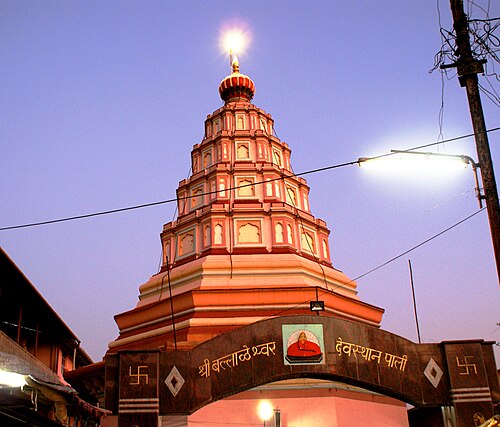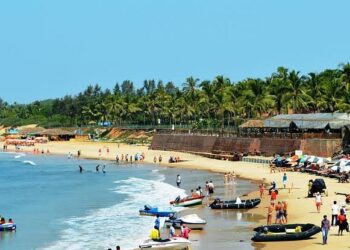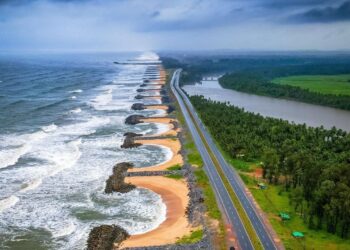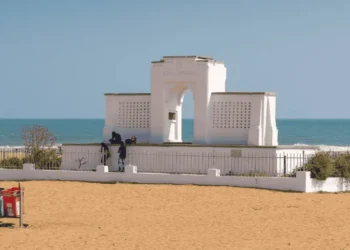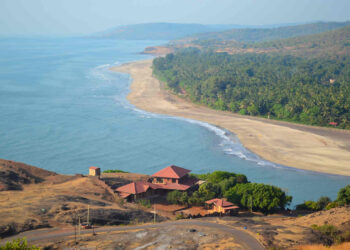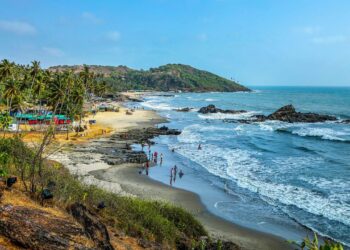The Ballaleshwar Temple in Pali, Raigad district, is dedicated to Lord Ganesha as Ballaleshwar. Set by the Amba River, about 110 km from Mumbai, it is the only temple among others that is known by his devotee’s name. Spanning roughly 1 acre, it’s the fourth stop of the Ashtavinayak pilgrimage, a journey to the eight sacred Ganesha temples.
Historical Overview
The Ballaleshwar temple was constructed by Moreshvar Vitthal Sindkar in 1640 though some say worship began earlier. He was one of the major contributors of the work of Chatrapati Shivaji. The Peshwas, Maratha rulers who revered Ganesha, added halls and walls in the 1700s, as stone writings show. The temple faced damage during Islamic invasions in the 1600s, but devotees hid the Ganesha murti idol in a nearby cave to keep it safe. It was later rebuilt in the 1800s with help from local chieftains. From the 1900s, the Endowments Department started maintaining the sanctity of the temple.
Mythological Importance
A beautiful legend regarding the temple says that in the Konkan Pallir village now known as Pali, there lived a young boy named Ballal who was a very sincere devotee of Lord Ganesha. Son of a rich businessman, his pre-occupation with worship at a young age displeased his father immensely. Ballal used to spend a large part of his time in worship and influenced his friends to do so as well. His friends’ parents felt that Ballal was misleading their children by showing them the Bhaktimarg(the path of devotion) at such a young age. Thus they complained and asked Ballal’s father to restrain his son. Filled with rage, his father went to look for Ballal and found him in the forest engrossed in his worship of Lord Ganesha. He disrupted the puja, threw away the murti of Ganesha and started to beat his son without mercy. This still didn’t dispel his rage so he tied him to a tree. He left Ballal in that forest asserting that let Lord Ganesh himself come and rescue him.
Ballal despite being in great pain kept calling upon Lord Ganesh tearfully. Listening to his bhakta’s sincere prayer, Ganesha took the form of a Brahmin and appeared before him. He set Ballal free and asked him to make a wish. Ballal entreated Lord Ganesh to reside in this region from thereon. Ganesha acquiesced and resided in a stone which is now believed to be the murti of Ballaleshwar Vinayaka, worshiped at Pali. The murti that Ballal’s father had desecrated too was placed in the temple. The murti of Dhundivinayak nearby is believed to be that same murti. His murti, carved from black stone, shows him with a grand form, standing for obstacle-removal and protection. The murti, found in a lake, in fact is said to be self-manifested.
Temple Structure and Design
The Ballaleshwar Temple is crafted in the Hemadpanthi style, a 13th-century Maratha art. Built in the shape of the letter Shri(श्री), it was made by mixing lead with the cement during construction. The east-facing temple was carefully positioned so that, as the sun rises, sun rays fall directly on the murti during worship. The temple sits by a small lake, with a stone dome and thick walls. The gopuram, restored in the 1800s, stands proud with stone carvings of Ganesha with his trunk raised, sages praying, and elephants, framed by lotus and vine patterns. Painted in soft cream and ochre, it’s capped with a simple kalasa that catches the morning light. The sanctum houses a black-stone Ganesha idol, draped in gold cloth and fresh garlands, set beneath a white-painted vimana, its stepped roof symbolizing purity. The sanctum’s walls, smoothed by time, carry faint Peshwa-era etchings of Ganesha’s tales, glowing under oil lamps.
Set by the Amba River, the temple is reached by a short stone path from Pali village, winding past neem and peepal trees. The courtyard, paved with uneven basalt, feels open yet sacred, fringed by old banyan trees that cast dappled shade. A small tank, fed by the nearby lake, is used for ritual dips, its edges carved with fish shapes, a Peshwa touch. The temple’s low walls, built from rough stone, have niches for Naga figures, believed to protect the grounds.
Rituals and Festivals
Ganesh Chaturthi in August or September is the most celebrated festival in the temple, marking Ganesha’s birth, with modak offerings and marches. Magh Shukla Chaturthi in January or February has homams (fire rituals) and idol worship. Sankashti Chaturthi, every month, sees lamp-lighting by the sanctum. Daily worship covers Suprabhata Seva (morning prayers), Archana (offerings), and Deeparadhana (lamp ritual). Services like Abhishekam and Ganapati Homam can be booked at the temple office. A prasad stall gives free laddoos for devotees. Modak Archana, giving sweets on Wednesdays, is for clear minds.
Information for Travelers
Hours and Entry: Open daily, 5:00 AM to 12:00 PM, then 3:00 PM to 9:00 PM. Entry is free, but rituals cost 50-300 rupees.
Clothing: Wear simple clothes covering shoulders and knees. Men doing rituals wear dhotis and go bare-chested, as custom.
How to Get There:
Air: Mumbai International Airport, 110 km away, is closest. Taxis take 2.5 hours, costing 2500-3500 rupees.
Train: Karjat Railway Station, 30 km away, links to Mumbai (1 hour) and Pune (2 hours). Autos to Pali cost 300-500 rupees.
Road: Pali is 30 km from Karjat. Buses from Karjat Bus Stand (1 hour) stop at Pali village, 1 km away. Autos cost 20-40 rupees.
Best Time to Visit: October to March has good weather, 20-30°C. Weekdays are calm. Ganesh Chaturthi packs crowds, so book early.
